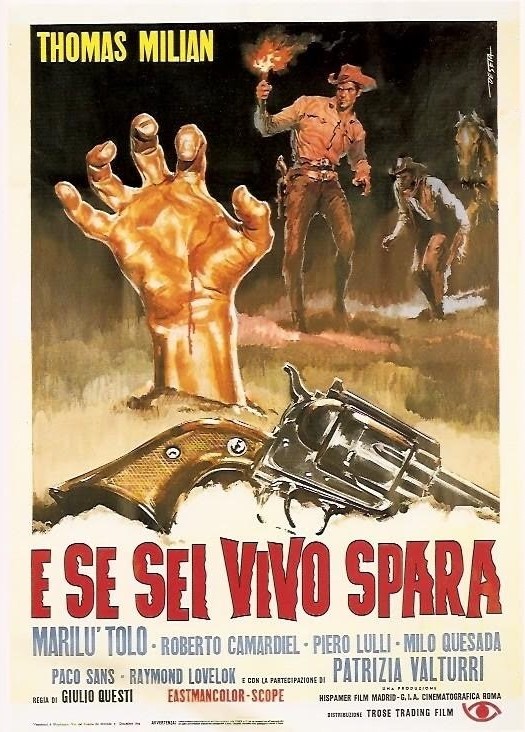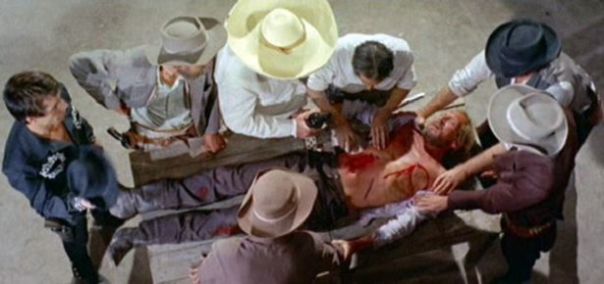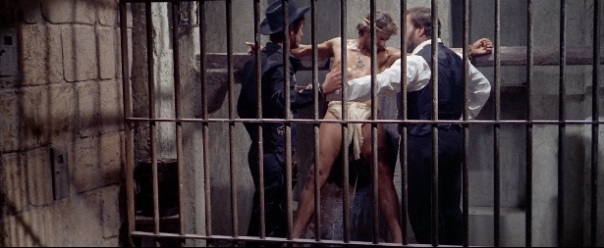Monthly Archives: January 2018
DJANGO KILL..if you live shoot! (1967)
A notoriously over-the-top Spaghetti/Euro Western which I had surprisingly not seen until very recently. You initially think this is going the way of the usual Western revenge tale but it’s a very unique entry in the genre. It has bags of character including vampire bats, a band of well-tailored homosexual cowboys, a fairytale damsel-in-distress locked in a room in an attic and a finale which includes our villain’s face becoming encased in molten – and naturally, stolen – gold.

Much of Questi’s film makes overtures to the horror genre, through both characterisations and visuals. Right from the off we get this, with the Stranger literally crawling out of his grave to be rescued by two Native Americans, who give him gold bullets with which to avenge his demise and recover the gold looted from his band of Mexican bandits. Some have gone so far to suggest that the Stranger is actually supernatural but I don’t think so, at least not in the same way as Eastwood’s character in High Plains Drifter (1973) and Pale Rider (1985).
When the Stranger arrives in a nearby town, following the outlaws who murdered his friends and stole from him, he finds they have been already despatched and strung up in the street by the good people of the town who are hiding the gold for themselves. The cattle-baron ‘Sorrow’ runs the town and is suspicious of the inhabitants’ motives for killing the outlaws; he too becomes transfixed on finding the gold at whatever cost. Francisco Sanz’s unscrupulous Preacher and Robert Camardiel’s hedonistic ‘Sorrow’ are the stand-out performances here, whilst Tomas Milan’s Stranger (or Django-like character, as he isn’t named in the film) is an under-played one.
Technically speaking, this is one well-lensed and easy-on-the-eye film. The film is not as packed with shoot-outs and violence as one may suspect from a slavish attempt to capitalise on the Django franchise, but when the vehemence does come it’s choreographed and edited brilliantly.

The film’s notable for several moments, but the most memorable is probably when original thief ‘Oaks’, whilst still alive, is carelessly torn apart by the doctor and townsfolk looking for the gold bullets that are peppered throughout his body. There’s an offbeat scene in which the Stranger – dressed like Jesus in a loin cloth – is placed on a crucifix (this is where the vampire bats make an appearance) and tortured by Sorrow’s gang with all manner of animals.

It’s perhaps not a film you’d expect Lee Van Cleef to turn-up in but beneath the unusual charms I’d argue there’s a strong thematic message from director Giulio Questi. The major one is around the dangers of possession and greed, familiar to many horse-operas. As the stolen gold passes from one group to another, their ensuing corruption and greed irrevocably seals their fate. On the outside the townsfolk look like honest law-abiding citizens but even the outlaws can feel something amiss as they ride into town, and once the gold is introduced their blood-lust becomes insatiable. It’s not just the desire to possess wealth that drives these people; we are introduced to numerous sub-plots where the desire to possess people is just as strong. The Preacher locks his wife in a room upstairs to prevent her falling in love with anyone else ; whereas the saloon owner’s son – who ends-up shooting himself after it is heavily implied he is raped by Sorrow’s gang – is possessive of his father and refuses to contemplate him marrying another woman.
Questi has apparently said that the film is something of an allegory for Italian society during fascism. Indeed, Questi’s focus on Sorrow’s cowboys – all dressed in black-uniforms – is undeniably a run on an anti-fascist message and puts the imagery in the scene in which they torture the Stranger on a cross into a peculiarly emotive perspective. The complicity and puppet-mastery of Sanz’s Preacher during the course of the film suggests at Questi’s disdain for the organized church.
Ivan Vandor’s catchy, if repetitive, score is a fitting accompaniment to the bizarre goings-on. It may be as crazy as a monkey but it’s an immortal slice of Spaghetti cinema.